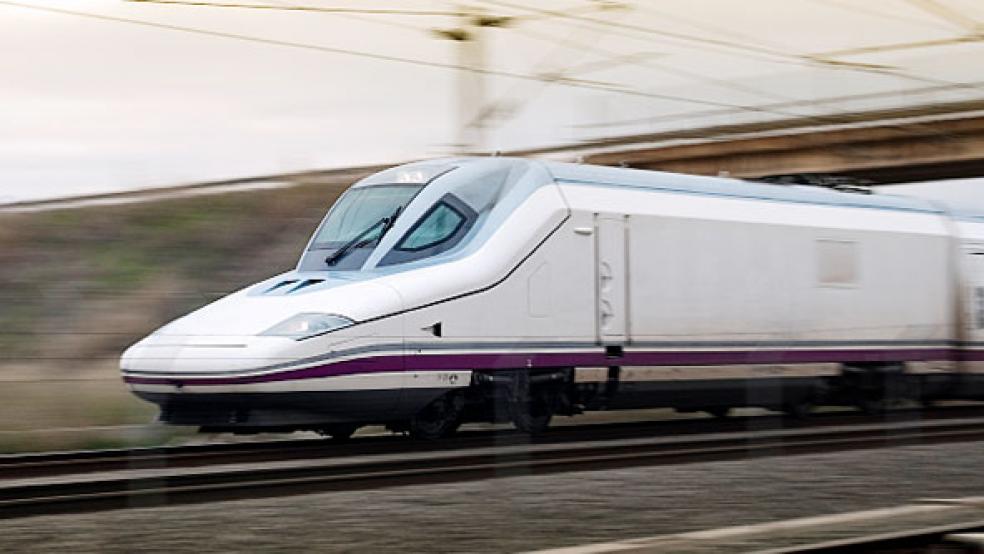President Obama says he can fix our broken economy and just needs more time to get the country humming. But his policies are inherently flawed. His choices (and several off-teleprompter remarks) show clearly his disregard for the key role of the private sector in boosting our debt-ridden economy. Two notable decisions - the veto of the Keystone Pipeline and his endorsement of California’s high-speed rail venture – are instructive.

Both projects would provide construction jobs – and both were sought by organized labor, which normally attracts Mr. Obama’s backing. But while the president turned down the Keystone Pipeline -- a privately-funded for-profit venture that would be self-sustaining and add to federal coffers -- he embraces bullet trains that will almost surely land on eternal government life-support. Think of high-speed rail as the Julia of public works projects.
President Obama threw $8 billion into the 2009 stimulus pot for high-speed rail. Most of the proposed initial projects were rejected by Republican governors who saw them as impractical boondoggles the country (and their states) could ill afford. In Florida, the planned bullet train was to run between Orlando and Tampa, cities that the New York Times described as “virtually unnavigable without cars” and that are so close that the high-speed train would have been no quicker than driving. Most recently, though, California – a state that just took an ax to its education and anti-poverty programs to close a $15.7 billion deficit – decided to go ahead with a high speed train, with President Obama’s blessing. Go figure.
The cost of the proposed train has risen from initial estimates of $33 billion back in 2008 to between $68 and $98 billion.
California is the most indebted state in the union, boasting the country’s lowest bond ratings. The state’s cities are teetering under the weight of pensions and benefits that have just recently driven three -- Stockton, San Bernardino and Mammoth Lakes—into bankruptcy. Both personal and business taxes are among the highest in the nation.
None of this has swayed the loons in the state’s legislature who recently gave thumbs-up to the first leg of the high-speed project. Meanwhile, the cost of the proposed train has risen from initial estimates of $33 billion back in 2008, when voters approved a first round of borrowings to launch the effort, to between $68 and $98 billion.
As projected costs soared, authorities dumbed down the project. Instead of a train speeding along at 220 miles per hour between Los Angeles and San Francisco, the service will now run partly along existing track, making more stops and taking almost three and a half hours – nearly twice as long as once imagined. More bow and arrow than bullet train.
Because the train by law is supposed to pay its own way, ticket prices are expected to be as much as $123, higher than air fares which routinely run $99 for the hour and a quarter long flight. Moreover, it was decided that the first stretch will be constructed between Madera (near Fresno) and Bakersfield, dividing rich agricultural lands and infuriating local communities who have attempted to block the plan. More important, the stretch would reach few of the business types that are targeted by planners of the bullet train.
Needless to say, public enthusiasm for the venture has dropped; 59 percent of Californians recently signaled they would not vote for it today and 69 percent said they would likely never or rarely use the train.
California runs a real risk of using existing financing of $6 billion to complete the initial segment and then running out of money, leaving residents with a literal “train to nowhere.
Legislators, though, did not want to lose out on $3.3 billion in matching federal funds which go away come September. Pursuing the short-term windfall could prove disastrous; California runs a real risk of using existing financing of $6 billion to complete the initial segment and then running out of money, leaving residents with a literal “train to nowhere.”
The California High-Speed Rail Peer Review Group, established by law in 2008, declined to endorse the project in January and described it as an “immense financial risk”. The oversight body criticized the rail authority for not having a business model, nor any plan for securing future funding. As the report says, past large-scale transportation programs like the interstate highway system had in place an authorized tax on gasoline which would cover future spending. No such funding stream exists for high-speed rail.
In his 2011 State of the Union speech, President Obama promised that “Within 25 years, our goal is to give 80 percent of Americans access to high-speed rail.” That goal, and the $53 billion of taxpayer funds allocated to the sector in Mr. Obama’s 2012 budget, were set by the president even though his administration reportedly failed to perform any cost-benefit analysis on high speed rail – a shocking display of pie-in-the-sky insouciance.
At a conference on high-speed rail this week, Transportation Secretary Ray LaHood claimed the Obama administration’s proposals are “off to a great start.” He also said that “we’re learning from our colleagues around the world”. Have they learned that only two high speed rail lines in the world run at a profit? And that even those required huge subsidies to get off the ground? High-speed rail, like the Concorde, seems to offer a nifty but ultimately uneconomic way to travel.
In the United States, we have always set our sights high. We expect to lead the world in technology, and in quality of life. It is galling to see the Chinese run rings around us in high-speed rail. President Obama is understandably frustrated. But to seek what The New York Times calls a “legacy” undertaking like high speed rail during a period of economic distress makes no sense and cannot be supported by voters. To not even assess the ultimate cost-effectiveness of the program is reckless. What should be supported is profitable spending by private businesses – like building the Keystone Pipeline, which will rebuild federal coffers and create jobs. That, unfortunately, is not President Obama’s vision.





